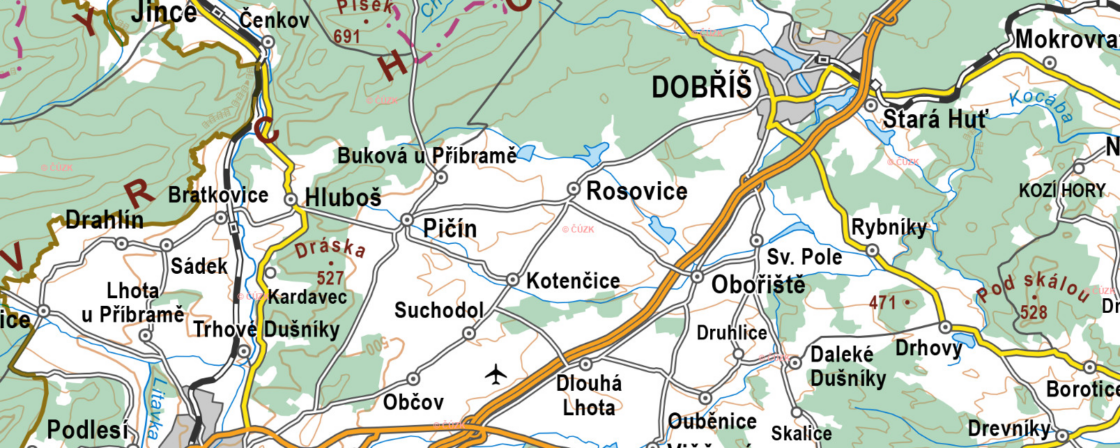Inconsistency in the Land Registry
It may happen that the information in the Land Registry does not match the real situation. For example, the cadastral map shows the boundaries of your property one metre to the left, while you have lived your whole life believing that they are one metre to the right and that there has been a brick fence on the site for decades. Or maybe you know about this discrepancy because you built a pergola in your garden last year.
In any case, this mismatch can cause major problems. It can prevent you from getting planning permission or selling the property. In some cases, this can be remedied through the registration of a note in the Land Registry and other legal steps. Let’s take a closer look at this option.
Are you solving a similar problem?
Does the cadastral data not match?
Leave it to us. We will find out what your legal problem is and propose a solution, including a fixed price. You will receive a proposal and quote within 24 hours and if you use our services to solve your problem, we will refund your fee.
I want to help
- When you order, you know what you will get and how much it will cost.
- We handle everything online or in person at one of our 6 offices.
- We handle 8 out of 10 requests within 2 working days.
- We have specialists for every field of law.
Note in the cadastre
A note is, in addition to the entry and recording, one of the methods of registration in the Land Register. It records important information about the property, but it does not have legal consequences. It is therefore a kind of notice that something is happening to the property that could affect the decision to deal with it legally. There are a number of types of notes; for the purpose of correcting a discrepancy in the land register with the actual situation, a note of discord and a note of contentiousness are used.
Note of discord
A note of discord is possible in a situation where the information on the real property right registered in the cadastre does not correspond to the actual situation. This is a situation where the right in rem has been registered in the past but the real situation has changed and the information in the cadastre does not correspond to reality. This is usually the case when the property is sold and the contract is subsequently withdrawn or when the sale does not result in a change of the owner in the cadastre,
Example: Mrs Novotná bought a property from Mr Kral for an agreed purchase price of CZK 5 million. The purchase contract was signed and the ownership was registered in the Land Registry, where Ms Novotná became the official owner of the property. However, after the transfer of ownership, Ms Novotná discovered that the property had hidden defects and therefore decided to withdraw from the purchase agreement.
Even though the contract has been withdrawn and the legal effects of the withdrawal have come into effect, Ms Novotná remains registered as the owner of the property in the Land Registry. Withdrawal from the contract is not automatically linked to a change in the land register – this requires further legal steps.
If the other party cooperates, a note of discord is not necessary. It is enough to solve the problem by an out-of-court agreement and a so-called consent declaration on the creation, change or termination of the right to the property, which is filed with the cadastral office.
However, if the other party does not cooperate and refuses the declaration of consent, it is necessary to file a lawsuit in court to establish the ownership right and then file a petition for registration of the note of discord in the Land Registry. This in itself has no legal consequences (that is what the lawsuit is for), but it will let everyone know that the property is subject to legal proceedings.
Tip for article
Tip: Want to sue and not sure if you will win? We will assess your chances of success in court and suggest a solution that will lead to the desired outcome.
Note of mootness
The note of mootness is here for situations where the right in rem has never been registered in the cadastre, i.e. in a situation where the owner of the property registered in the cadastre is not and never has been the actual owner.
At the same time as the note of contestability, a claim for the establishment of the ownership right must also be filed. You have one month from the time you became aware of the error in the cadastre to file this action – this date is considered to be the date on which the erroneous entry was made (ignorance is no excuse). However, in practice, if you were not informed of the registration of the right in rem, you have a period of 3 years, which started on the date of the erroneous registration. However, even here it is possible to resolve the situation by means of a declaration of consent without the need for a note of dispute and an action to establish title.
Example: Mr Dvořák owned a property that he inherited from his parents. However, during the inheritance proceedings, an administrative error occurred and the property was mistakenly registered in the Land Registry in the name of another heir, Mr Svoboda.
After several years, Mr Dvořák noticed that Mr Svoboda was registered as the owner in the land register, which did not correspond to the actual situation, as Mr Svoboda had never acquired the property. Mr Dvořák was therefore not informed of the erroneous registration and only became aware of the problem after the time had elapsed since the registration in the cadastre. Since he was not informed of the registration, he has 3 years from the date of the erroneous registration to bring an action to establish ownership.
Action for determination of ownership
Let’s take a closer look at how the aforementioned action for determination of ownership, or the action for determination of title, works. The purpose of a title action is to determine who owns the property and, if so, to what extent. It is also used in a situation where a dispute over the boundary of the land, which can be objectively determined, is being resolved.
At least one of the parties (plaintiff or defendant) must be the person registered in the Land Register. If you would like to bring a claim for the determination of ownership, just contact us.
How to register a note
The application for registration of a note can be sent by post, handed in person or sent electronically by email with an electronic signature to the address of the electronic filing office or sent by data box. It must be sent to the address of the relevant cadastral office (i.e. the place where the property is located).
The application can be submitted by filling in the official form, which can be found directly on the Land Registry’s website. If the proposal was created in paper form but you are submitting it electronically, you must have it converted into electronic form using authorised conversion. You can arrange this, for example, at the post office, the office or a notary. The form must then be accompanied by the document on the basis of which the note is to be recorded and, if applicable, a power of attorney.
Once the Land Registry receives your proposal, it will mark the property in question with a seal indicating that the rights to it are affected by the change no later than the following day. It will then decide whether or not to accept the registration and remove the seal. If it refuses to register the note, it will inform you of this, together with the reasons for its decision.
Summary
Inconsistencies between the information in the Land Registry and the actual situation can lead to problems – for example, difficulties in selling a property or obtaining a building permit. The solution lies in a note of discord or disputability, which is entered in the Land Registry as a notice of a dispute over a property right, and a title action, which serves to formally establish ownership rights to a specific property.




